

Herschel’s infra-red experiment. This is a recreation of Herschel’s experiment, published in 1800, in which he discovered infra-red radiation.
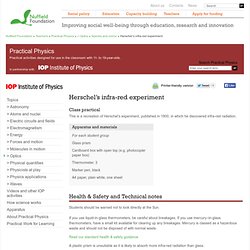
For each student group Glass prism Cardboard box with open top (e.g. photocopier paper box) Herschel’s infra-red experiment. Ritter Ultraviolet Experiment - an Example. After hearing about William Herschel's discovery of infrared light in 1800, Johann Ritter decided to see if he could detect light beyond the other end of the spectrum - past violet.
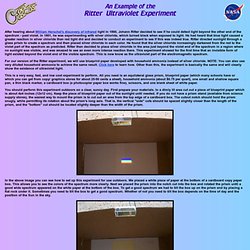
In 1801, he was experimenting with silver chloride, which turned black when exposed to light. He had heard that blue light caused a greater reaction in silver chloride than red light did and decided to conduct an experiment to see if this was indeed true. Ritter directed sunlight through a glass prism to create a spectrum and then placed silver chloride in each color. He found that the silver chloride increasingly darkened from the red to the violet part of the spectrum as predicted. Ritter then decided to place silver chloride in the area just beyond the violet end of the spectrum in a region where no sunlight was visible, and was amazed to see an even more intense reaction there. This is a very easy, fast, and low cost experiment to perform. Sonoluminescence. Single-bubble sonoluminescence - A single, cavitating bubble.
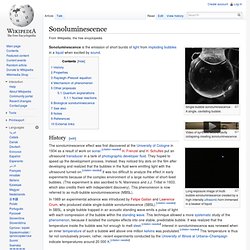
Video of synthetic wound cavity collapsing creating sonoluminescence. Long exposure image of multi-bubble sonoluminescence created by a high-intensity ultrasonic horn immersed in a beaker of liquid History[edit] The sonoluminescence effect was first discovered at the University of Cologne in 1934 as a result of work on sonar. [citation needed] H. In 1989 an experimental advance was introduced by Felipe Gaitan and Lawrence Crum, who produced stable single-bubble sonoluminescence (SBSL).
Properties[edit] Sonoluminescence can occur when a sound wave of sufficient intensity induces a gaseous cavity within a liquid to collapse quickly. Some facts about sonoluminescence: Rayleigh–Plesset equation[edit] The dynamics of the motion of the bubble is characterized to a first approximation by the Rayleigh-Plesset equation (named after Lord Rayleigh and Milton Plesset): Mechanism of phenomenon[edit] In 2002, M. Other proposals[edit] [edit]
The Physics of Color. New generation laser will herald technological breakthrough. Research into a new type of laser will dramatically improve future devices used for sensing and in communications, according to scientists at the University.
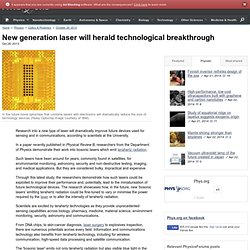
In a paper recently published in Physical Review B, researchers from the Department of Physics demonstrate their work into bosonic lasers which emit terahertz radiation. Such lasers have been around for years, commonly found in satellites, for environmental monitoring, astronomy, security and non-destructive testing, imaging, and medical applications. But they are considered bulky, impractical and expensive. Through this latest study, the researchers demonstrate how such lasers could be exploited to improve their performance and, potentially, lead to the miniaturisation of future technological devices. The research showcases how, in the future, new 'bosonic lasers' emitting terahertz radiation could be fine-tuned to vary or minimise the power required by the laser or to alter the intensity of terahertz radiation. First phonon (sound) laser created at Max Planck Institute.
Scientists at the Max Planck Institute of Quantum Optics (Garching, Germany) and the California Institute of Technology (Pasadena, California, U.S.A.) used a process called stimulated emission to create the first-of-its-kind phonon laser.
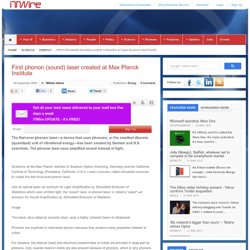
Like an optical laser--an acronym for Light Amplification by Stimulated Emission of Radiation --which uses emitted light, the “sound” laser, or phonon laser, is called a “saser"--an acronym for Sound Amplification by Stimulated Emission of Radiation . The saser, also called an acoustic laser, uses a highly coherent beam of ultrasound. Phonons are important in solid-state physics because they produce many properties inherent in solids. For instance, the thermal (heat) and electrical conductivities of solids are provided in large part by phonons. Tree of Life Tech. Crystal Laser Bed - Home. In Physics, What Is a Phonon? How To Steer Sound Using Light. Zap an optical fibre with a couple of laser beams and the resulting interference pattern causes an interesting effect–it squeezes the material, an effect known as electrostriction.
This creates a compression wave called a phonon, a packet of sound, which travels along the fibre. Not to be outdone, phonons also influence light because they change the refractive index of the material. This bends light and alters its frequency, an effect known as Brillouin scattering. After that, things get complicated. This mechanism sets in train a complex set of feedback effects in which photons generate phonons which influence the photons and so on. The problem is understanding what’s going on.
That looks set to change. Today, Jean-Charles Beugnot and Vincent Laude at Université de Franche-Comté in Besançon, France, take a more detailed at look the problem. Their conclusion has interesting implications. Beyond this,the most exciting application is in information processing. Red, blue and Green Laser Pointers, Green Laser, laser pointer - PerfectLasers.net. High-power, 532 nm-wavelength compact green laser module with high efficiency, high-speed modulation capability. QD Laser, Inc., the Institute for Nano Quantum Information Electronics, the University of Tokyo, and Fujitsu Laboratories Limited today announced the successful development of a high-power 532 nm-wavelength compact green laser module with high efficiency and high-speed modulation capability.
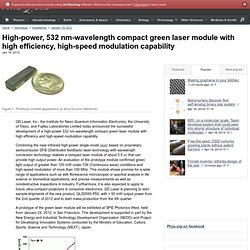
Combining the near-infrared high-power single-mode laser based on proprietary semiconductor DFB (Distributed feedback) laser technology with wavelength conversion technology realizes a compact laser module of about 0.5 cc that can provide high output power. An evaluation of the prototype module confirmed green light output of greater than 100 mW under CW (Continuous wave) conditions and high-speed modulation of more than 100 MHz. This module shows promise for a wide range of applications such as with florescence microscopes or spectral analysis in life science or biomedical applications, and precise measurements as well as nondestructive inspections in industry.
Laser treatment with 532 nm wavelength offers numerous advantages. Key Points Absorption of light by hemoglobin is higher at 532 nm than 585 nm pulsed-light wavelengthThe 532 nm wavelength can reach the superficial dermis for treatment of facial vessels, but it is not suitable for deeper vessels Acne Although not considered a first-line treatment for acne, there are a few published reports of using KTP for acne.
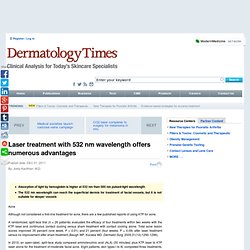
A randomized, split-face trial (n = 26 patients) evaluated the efficacy of four treatments within two weeks with the KTP laser and continuous contact cooling versus sham treatment with contact cooling alone. Total acne lesion scores improved 35 percent (one week, P < 0.01) and 21 percent (four weeks, P = 0.09) after laser treatment versus no improvement after sham treatment (Baugh WP, Kucaba WD. Light: Medicine of the Future: How We Can Use It to Heal Ourselves NOW - Jacob Liberman - Google Books.